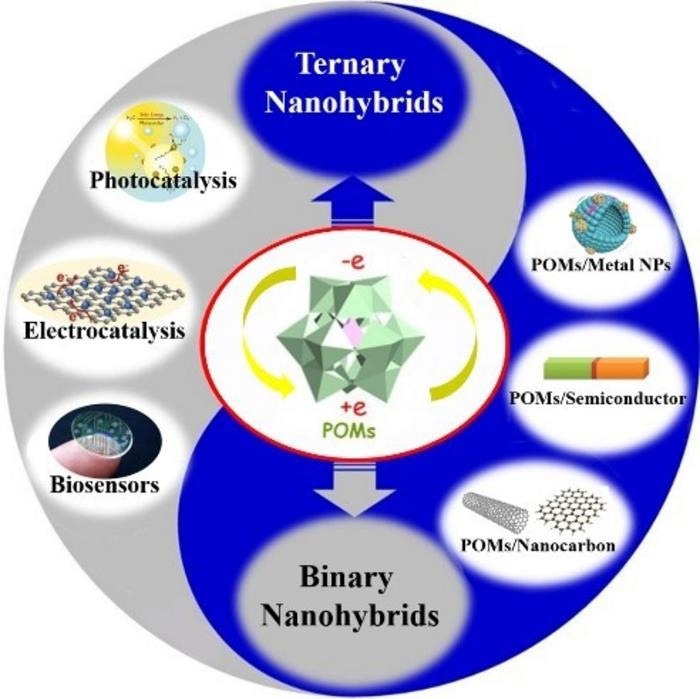Polyoxometalate (POM)-based nanohybrids have the potential to revolutionize sustainability in numerous industries, but research on these materials is still in its early stages. In a review paper published Polyoxometalates, the authors present a thorough assessment of the field's advancements and the hurdles that lie ahead.
 Cartoon Showing Potential Applications And Varieties Of Pom-Based Nanohybrids. Image Credit: Polyoxometalates, Tsinghua University Press
Cartoon Showing Potential Applications And Varieties Of Pom-Based Nanohybrids. Image Credit: Polyoxometalates, Tsinghua University Press
In recent decades, a new class of nanoscale materials, or more simply nanomaterials, has emerged in which a single unit enjoys dimensions in the range of 1-100 nanometers. At this scale, materials can exhibit unique and often enhanced physical, chemical, and biological properties that vary from more huge or bulk materials.
For instance, nanoscale materials can have a higher surface area-to-volume ratio, which can increase their reactivity and ability to catalyze chemical reactions.
Graphene is arguably the most renowned nanomaterial, yet nanomaterials can be crafted from a diverse array of materials, encompassing metals, semiconductors, ceramics, and polymers. In recent times, scientists have additionally created nanohybrids, which are compounds that merge two or more distinct types of nanomaterials.
Scientists aim to make industrial production more sustainable that Polyoxometalate (POM) based nanohybrids have unique catalytic properties within photoelectrochemical reactions - those that generate electricity from light, or split water into cleanly produced hydrogen and oxygen. This enables the POM nanohybrids to be promising candidates for a wide range of applications, including clean energy conversion and storage, as well as sensors and electronics without depending on the use of dirty energy sources.
POMs, or polyoxometalates, represent an extensive category of cost-effective and resilient inorganic compounds composed of metal ions, typically transition metals like tungsten or molybdenum. These compounds are interconnected by oxygen atoms, forming a three-dimensional lattice. POMs are known for their significant molecular size and complexity, which results in a diverse range of shapes and dimensions. Moreover, they demonstrate a wide array of intriguing and practical properties.
There’s been an explosion of research into POM nanohybrids in the last few years, and so we thought it time to pause, and produce an overview of the current state of play in order to identify potential research gaps and controversies.
Guangjin Zhang, Corresponding Author, Chemist, Key Laboratory of Green Process and Engineering, Chinese Academies of Sciences
Scientific review papers play a crucial role in the scientific process as they aim to condense and assess the current state of knowledge within a specific scientific field. These papers critically evaluate the quality and reliability of existing literature while proposing potential avenues for future research.
The Appeal of POMs
In their review, the authors emphasize the appeal of POMs due to their ability to enhance the photoelectrochemical catalytic characteristics of resulting nanohybrid materials. POMs' dual role as electron acceptors and donors promotes the efficient transfer of electric charge, thereby improving the effectiveness of associated reactions. Additionally, POMs can also serve as catalysts in their own right, further augmenting the catalytic attributes of the nanohybrid material.
The review also delves into the distinction between binary and ternary POM-based nanohybrids. Binary nanohybrids are composed of two distinct nanoscale materials, while ternary nanohybrids incorporate three. Binary variants merge POM with a metal, POM with a semiconductor, or POM with a nanocarbon, whereas ternary nanohybrids encompass POM, a metal, and a nanocarbon.
The authors highlight that binary nanohybrids have been extensively researched and have demonstrated promising outcomes across various applications, such as photocatalysis, fuel cells, and biosensors. In contrast, ternary nanohybrids possess the potential to amalgamate the distinct properties of three diverse materials, leading to even greater functionality and versatility.
In an unrelated context to sustainable energy, POM-based nanohybrids demonstrate significant potential in the realm of biosensors. Biosensors are instruments that identify and quantify biological or chemical substances in a sample by detecting alterations in electrical signals stemming from biochemical reactions.
These nanohybrids, distinguished by their substantial surface area and the capacity to immobilize biomolecules, are exceptionally well-suited for deployment in such devices. Notably, researchers have already harnessed POM-based nanohybrids to create biosensors with heightened sensitivity, capable of detecting substances like simazine and hydrogen peroxide.
These biosensors hold promise for diverse applications, ranging from medical diagnostics to environmental monitoring. Moreover, emerging applications span water purification, semiconductors, and 3D printing.
Challenges Ahead
A primary challenge encountered by researchers in this domain is the fact that, while ternary POM-based nanohybrids hold the promise of even greater performance enhancements, the research in this area is still growing. Consequently, there exists a limited comprehension of the properties and behavior of ternary nanohybrids. Exploring their potential applications is an ongoing endeavor, and challenges may arise in the development and optimization of ternary nanohybrids for specific purposes.
Furthermore, across all types of POM-nanohybrids, the solubility of POM molecules within these hybrids can compromise their catalytic performance. The non-uniform dispersion of POMs on or within conductive materials persists as a recurring issue. Additionally, when combined with metals or metal oxides, achieving control over the size and shape of particles remains a formidable task.
The authors contend that placing more emphasis on establishing a fundamental understanding of the connection between the structure of these hybrids and their chemical reactivity is vital in surmounting the hurdles impeding broader applications. They advocate for increased collaboration across various disciplines to address these challenges effectively.
Journal Reference:
Zhang, S., et al. (2023). Design and synthesis of novel polyoxometalate-based binary and ternary nanohybrids for energy conversion and storage. Polyoxometalates. doi.org/10.26599/POM.2023.9140037